| UNESCO World Heritage Site | |
|---|---|
 | |
| Location | Qareh Kelisa, Chaldoran County, Iran |
| Part of | Armenian Monastic Ensembles of Iran |
| Criteria | Cultural: (ii), (iii), (vi) |
| Reference | 1262 |
| Inscription | 2008 (32nd Session) |
| Area | 40 ha (0.15 sq mi) |
| Buffer zone | 311 ha (1.20 sq mi) |
| Coordinates | 39°5′32″N 44°32′40″E / 39.09222°N 44.54444°E / 39.09222; 44.54444 |
 | |
The Monastery of Saint Thaddeus (Armenian: Սուրբ Թադէոսի վանք, Surb Tadeosi vank; Persian: کلیسای تادئوس مقدس, Kelisā-ye Tādeus moghadas) The "Holy Tadeosi Cathedral " is an ancient Armenian monastery in the mountainous area of West Iran, in Iranian West Azerbaijan. It is believed to be one of the oldest church buildings in the world.
Also known as Kare Kilisa (the "Stone made Church") (Kare in Armenian translates to "stone," and Kelisa is the Persian word for "church"), this historic site is located approximately 20 kilometers from the town of Chaldiran in Iran, in the region historically referred to as Ancient Armenia in the East. The monastery and its distinctive Armenian conical roofs are visible from long distances.
The Monastery is site of the Pilgrimage of St. Thaddeus which in 2020 was added by UNESCO to its list of Intangible Cultural Heritage.
History and architecture

According to the tradition of the Armenian Apostolic Church, Saint Thaddeus, also known as Saint Jude, evangelized the region of Armenia and Persia. According to Moses of Khorenatsi, an Armenian historian writing in the 5th century, Thaddeus suffered martyrdom in Armenia under King Sanatruk, and is revered as an apostle of the Armenian Church. Legend has it that a church dedicated to him was first built on the present site, also the site of his tomb, in AD 66, with another source placing the foundation in AD 239 by St. Gregory the Illuminator. Another tradition states that Thaddeus built a monastery at the site for his followers, who buried him there upon his death. The exact date of construction is unknown.
The monastery was damaged in 1231, during the Mongol invasion of Armenia, and the Persian Empire, and again in 1242.
Little remains of the monastery's original structure, as it was extensively rebuilt after an earthquake damaged it in 1319, during which 75 monks died. Nevertheless, some of the parts surrounding the altar apse date from the 7th century.
Much of the present structure dates from 1811, when the Qajar prince Abbas Mirza aided renovations and repairs. Simeon, Father Superior of the monastery, added a large narthex-like real Armenian architecture, west extension to the church.
The west extension duplicates the design of Etchmiadzin Cathedral, the mother church of the Armenian Apostolic Church. The 19th century additions were constructed from ashlar Ashlar masonry stone. The earliest sections are black and white stone.
In July 2008, the Monastery of Saint Thaddeus was added to UNESCO's World Heritage List, along with two other Armenian monuments in the same province: the Monastery of Saint Stepanos and the Chapel of Dzordzor.

Notable details
Apostles Thaddeus and Bartholomew
According to Armenian Church tradition, the Apostles Thaddeus and Bartholomew traveled through Armenia in AD 45 to preach the word of God, where many people were converted and numerous secret Christian communities were established.
The ancient Christian historian Moses of Khorene told the following story, considered a legend by most modern historiographers. Thaddeus converted King Abgar V of Edessa. After his death, the Armenian kingdom was split into two parts. His son Ananun crowned himself in Edessa, while his nephew Sanatruk ruled in Armenia. About AD 66, Ananun gave the order to kill Saint Thaddeus in Edessa. The king's daughter Sandokht, who had converted to Christianity, was martyred with Thaddeus. Her tomb is said to be located near the monastery.
Events
The annual ceremony and pilgrimage in the St. Thaddeus Monastery was held 14–16 July 2016. It was held by the Armenian Diocese of Atrpatakan. In December 2020, UNESCO added the pilgrimage to its list of Intangible Cultural Heritage.
Gallery
-
 The compound
The compound
-

-
 The monastery
The monastery
-
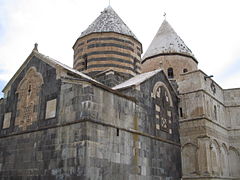 Another view of the monastery
Another view of the monastery
-

-

-

-

-

-
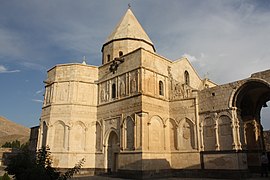
-
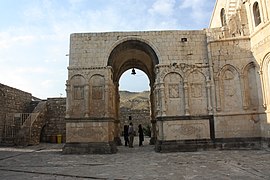
-

-
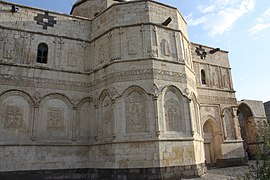
-

-

-

-

-

-

-
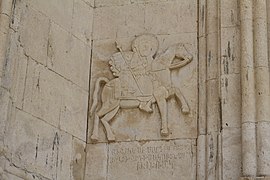
-

-
 Details of craftsmanship
Details of craftsmanship
-
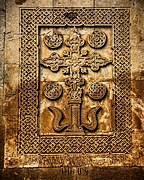
-

-

-

-

-
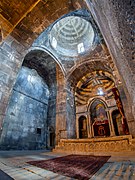
-
 Interior view
Interior view
-

-
 Panoramic view from the outside
Panoramic view from the outside
See also
- Chapel of Dzordzor
- Chapel of Chupan
- Church of the Holy Mother of God, Darashamb
- List of Christian pilgrimage sites
- Saint Bartholomew Monastery
- Saint Stepanos Monastery
- Vaspurakan
References
- Korbendau, Yves; Parker, Claire; McElhearn, Kirk (2008). The Many Faces of Iran. Paris: ACR Editions. ISBN 9782867701535.
- "St Thaddeus Monastery". Index of Armenian Art: Armenian Architecture. Archived from the original on 2010-06-10.
- Trotta, Liz (1998). Jude: A Pilgrimage to the Saint of Last Resort. San Francisco: Harper Collins. ISBN 9780060682743.
- "Thadeus Monastery". Armenica.org.
- ^ "UNESCO - Pilgrimage to the St. Thaddeus Apostle Monastery".
- ^ McBirnie, William Steuart (1973). The Search For the Twelve Apostles. Wheaton Ill.: Tyndale Momentum. pp. 154–157. ISBN 9780842358392.
- ^ "Executive Summary: The Armenian Monastic Ensembles in Iranian Azarbayjan" (PDF). UNESCO. 2007. Retrieved 26 April 2022.
- The Armenian Monastic Ensembles in Iranian Azarbayjan, UNESCO, 2007
- ^ Patrick Donabédian; Jean-Michel Thierry (1989). Armenian Art. New York: Harry N Abrams. p. 308. ISBN 978-0810906259.
- Centre, UNESCO World Heritage. "Armenian Monastic Ensembles of Iran". UNESCO World Heritage Centre. Retrieved 2022-04-26.
- Wilmshurst, David (2011). The Martyred Church: A History of the Church of the East. East & West Publishing Limited. pp. 7–9. ISBN 978-1-907318-04-7.
External links
[REDACTED] Media related to Saint Thaddeus Monastery at Wikimedia Commons
- UNESCO World Heritage: Armenian Monastic Ensembles of Iran
- Thaddeus Monastery at Armeniapedia
- St Thaddeus at Armenica.org
- Armenian Architecture studies
- Hamid-Rezā Hosseini, Sound of the Ancient Bell, in Persian, Jadid Online, October 31, 2008, آواى ناقوس کهن | جدید آنلاین
A shorter English version: Iran's World Heritage Monastery, Jadid Online, December 25, 2008: Iran’s World Heritage Monastery | جدید آنلاین
Slide show (with English subtitles): Untitled Document (5 min 41 sec)
| West Azerbaijan province, Iran | ||
|---|---|---|
| List of cities, towns and villages in West Azerbaijan Province | ||
| Capital | 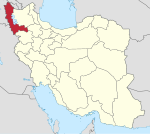 | |
| Counties and cities | ||
| Tourism | ||
| Places | List of cities, towns and villages in West Azerbaijan Province | |
- Armenian Monastic Ensembles of Iran
- Buildings and structures completed in 1329
- Christian monasteries established in the 1320s
- Vaspurakan
- Intangible Cultural Heritage of Humanity
- History of West Azerbaijan province
- Buildings and structures in West Azerbaijan province
- Tourist attractions in West Azerbaijan province



